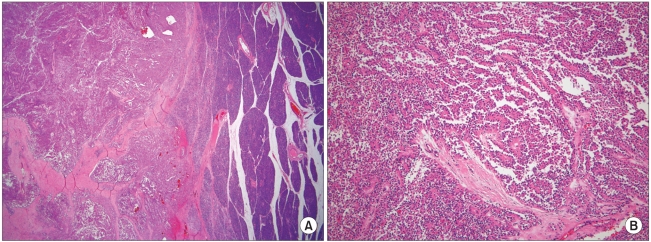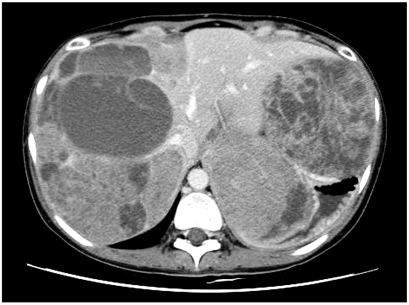Cancer Res Treat.
2006 Apr;38(2):118-120.
A Case of Recurrent Solid Pseudopapillary Tumor of the Pancreas with Involvement of the Spleen and Kidney
- Affiliations
-
- 1Department of Internal Medicine, College of Medicine, Chungnam National University, Daejeon, Korea. frkim@cnu.ac.kr
- 2Department of Pathology, College of Medicine, Chungnam National University, Daejeon, Korea.
- 3Cancer Research Institute, College of Medicine, Chungnam National University, Daejeon, Korea.
Abstract
- Solid pseudopapillary tumor of the pancreas (SPTP) is a rare primary pancreatic tumor of an unknown etiology that is usually diagnosed in adolescent girls and young women. Most SPTPs are considered to be benign and only rarely metastasize. We report here on a 27-year old woman with recurrent SPTP with involvement of both the spleen and left kidney at the time of the initial diagnosis, and with aggressive behavior. In July 1995, she was admitted with abdominal discomfort and mass. She underwent exploratory laparotomy with distal pancrea tectomy, left nephrectomy and splenectomy, and was diagnosed with SPTP with invasion to both the spleen and left kidney. In June 2001, she again presented with abdominal pain and was diagnosed as having recurrence of the tumor. She underwent mass excision and omentectomy. Then she was lost to follow-up. In November 2005, she presented once again with an abdominal mass and was diagnosed with recurred SPTP, which formed a huge intraperitoneal mass with peritoneal seeding and the tumor showed multiple metastases in the liver. She is currently being treated conservatively.
MeSH Terms
Figure
Reference
-
1. Frantz VK. Blumberg CW, editor. Tumors of pancreas. Atlas of tumor Pathology. 1959. 1st ed. Washington DC: Armed Forces Institute of Pathology;p. 32–33.2. Papavramidis T, Papavramidis S. Solid pseudopapillary tumors of the pancreas: review of 718 patients reported in English literature. J Am Coll Surg. 2005; 200:965–972. PMID: 15922212.
Article3. Mao C, Guvendi M, Domenico DR, Kim K, Thomford NR, Howard JM. Papillary cystic and solid tumors of the pancreas: a pancreatic embryonic tumor? Studies of three cases and cumulative review of the world's literature. Surgery. 1995; 118:821–828. PMID: 7482268.
Article4. Martin RC, Klimstra DS, Brennan MF, Conlon KC. Solid-psuedopapillary tumor of the pancreas: a surgical enigma? Ann Surg Oncol. 2002; 9:35–40. PMID: 11833495.5. Kloppel G, Solcia E, Longnecker DS. Histological typing of tumors of the exocrine pancreas. WHO international histological classification of tumors. 1996. 2nd ed. Berlin, Heidelberg, New York: Springer.6. Huang HL, Shih SC, Chang WH, Wang TE, Chen MJ, Chan YJ. Solid-pseudopapillary tumor of the pancreas: clinical experience and literature review. World J Gastroenterol. 2005; 11:1403–1409. PMID: 15761986.
Article7. Kingsnorth AN, Galloway SW, Lewis-Jones H, Nash JR, Smith PA. Papillary cystic neoplasm of the pancreas: presentation and natural history in two cases. Gut. 1992; 33:421–423. PMID: 1489379.
Article8. Cappellari JO, Geisinger KR, Albertson DA, Wolfman NT, Kute TE. Malignant papillary cystic tumor of the pancreas. Cancer. 1990; 66:193–198. PMID: 1693876.
Article9. Kosmahl M, Seada LS, Janig U, Harms D, Kloppel G. Solid-pseudopapillary tumor of the pancreas: its origin revisited. Virchows Arch. 2000; 436:473–480. PMID: 10881741.
Article10. Klimstra DS, Wenig BM, Heffess CS. Solid-pseudopapillary tumor of the pancreas: a typically cystic carcinoma of low malignant potential. Semin Diagn Pathol. 2000; 17:66–80. PMID: 10721808.11. Kang H, Song YJ, Koh YS, Joo JK, Kim JC, Cho CK, et al. Clinical features and surgical treatment of solid pseudopapillary tumor of pancreas. J Korean Surg Soc. 2005; 68:492–497.12. Nishihara K, Nagoshi M, Tsuneyoshi M. Papillary cystic tumors of the pancreas. Assessment of their malignant potential. Cancer. 1993; 71:82–92. PMID: 8416730.
Article13. Rebhandl W, Felberbauer FX, Puig S, Paya K, Hochschorner S, Barlan M, et al. Solid-pseudopapillary tumor of the pancreas (Frantz tumor) in children: report of four cases and review of the literature. J Surg Oncol. 2001; 76:289–296. PMID: 11320522.
Article
- Full Text Links
- Actions
-
Cited
- CITED
-
- Close
- Share
- Similar articles
-
- Solid Pseudopapillary Tumor of the Pancreas in Child: A Case Report
- A Case of Solid Pseudopapillary Tumor of the Pancreas Presenting as a Submucosal Tumor with Hemorrhage
- A First Case of Solid Pseudopapillary Tumor of the Pancreas in an Old Man in South Korea
- Solid pseudopapillary tumor with hepatic metastasis
- The Growth of an Extrapancreatic Solid Pseudopapillary Tumor from the Greater Omentum: A Case Report



